Similar to most of the developed countries/regions/cities, main bursts and leaks in the water supply networks of Hong Kong are perennial problems. What peculiar to Hong Kong are factors such as high water supply pressure due to the hilly topography, congested urban setting and the large number of underground utilities services which have posed huge challenges to us in maintaining a highly reliable and sustainable water supply network.
At the year of 2000, Hong Kong's fresh water and salt water supplies were provided through a network of about 5 700 kilometres of water mains. Most of these water mains were underground; and a substantial portion of which was not in good condition and had become increasingly difficult and costly to maintain. We had been facing an increasing number of main bursts and leaks causing inconvenience to the public and loss of precious water resources. The previous way of carrying out piecemeal and small-scale replacement works was not considered effective.
Thus, starting from 2000, we implemented a comprehensive and systematic management programme for the water supply networks, involving the replacement and rehabilitation (R&R) of about 3 000 kilometres of aged water mains in 4 stages to rejuvenate the water supply network. We have completed this 15-year Programme in 2015 and have spent about HK$23.6 billion for the works.
Upon the completion of the Programme, together with the implementation of the active leakage control and pressure management on water mains, the number of water main bursts dropped significantly by about 98% from over 2 500 in 2000 to around 40 and less in recent years with the number of leaks reduced at the same time.
Remarks: number of cases includes damage by other parties
Not withstanding the above achievements, our water main assets have grown to about 8 400 kilometres at end 2023 and these water mains will continue ageing. The risks of main bursts and leaks remain and could deteriorate if the networks were not properly managed.
To maintain the healthiness of the water supply networks and to reduce the risks of water main bursts and leaks, we are committed to the continuous effort and riding on the success of the earlier R&R Programme have implemented the “risk-based water main asset management strategy” to assess the risks of individual water mains, accord priorities to those with high risks for continuous improvement works.
The risks of bursts and leaks of water mains are assessed taking into account various factors including the consequence of bursts or leaks, ages and materials of the water mains, past records of bursts or leaks, surrounding environment, etc. Improvement works including replacement and rehabilitation are implemented under the risk-based improvement programme in a systematic manner. The details of the risk-based improvement programme are given below.
Design Division
Binnies Hong Kong Limited
AECOM Asia Company Limited
The conventional method to replace aged water mains is to lay new water mains alongside the existing water mains using trench opening method. Upon completion of making connections to the new water mains, the existing water mains will be abandoned. As this method will involve road opening for the whole section of the water main, the method will be generally acceptable when the traffic and environmental impacts arising from the works are not serious and when the underground utilities present are not congested.
At locations where traffic and environmental impacts are causing concerns, we may use trenchless techniques. These techniques are sometimes referred to as 'minimum dig' or 'reduced dig' techniques to accurately indicate the methods still require the opening of pits.
Trenchless replacement techniques involve the pre-drilling of a hole of suitable diameter and the insertion of a pipeline along the pre-drilled hole. Upon completion of making connections to the new water mains, the existing water mains will be abandoned. As the techniques need to avoid the already congested underground utilities, the pipelines will be laid deep underground which will lead to operation and maintenance problems. These replacement techniques will be limited to small areas with traffic and environmental problems. The main trenchless replacement techniques are described below –
Pipe Jacking
This method involves the jacking of a pipe sleeve from the launching pit using a hydraulic jacking machine to the receiving pit. The soil inside the pipe sleeve is removed and then a new pipeline is inserted into the pipe sleeve.
Size Range: Pipes of diameters over 900 mm
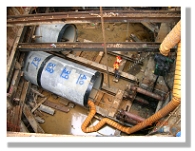
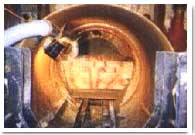
Horizontal Directional Drilling
In this method a pilot hole is drilled along a designed profile using a drilling rig. The pilot hole is then enlarged to a suitable diameter by 'prereaming' the hole successively to a larger diameter. Once the drilled hole is enlarged, the new pipeline is then installed by pulling a prefabricated pipe through the drilled hole.
Size Range: Pipes of diameters from 300 mm to 1 200 mm

Diagrammatic illustration on Horizontal Directional Drilling
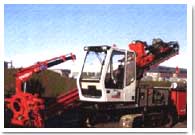
Rehabilitation methods are also classified as trenchless methods (sometimes referred to as 'minimum dig' or 'reduced dig' methods.). In these techniques, a new pipe is launched from a 'launching pit' and travels along the existing pipe route to a 'receiving pit'. Under ideal situation, a pipe can travel up to about 100 metres to 200 metres. In practice, bends in the existing water mains would shorten the length of the water main to be rehabilitated. The commonly adopted rehabilitation method is “Close Fit Lining Method”.
Close Fit Lining Method
Close fit lining technique involves the insertion of a temporarily reduced diameter or re-shaped polyethylene pipe as a lining into an existing water main. The inserted pipe will be reverted to its original size on completion of the insertion process and form a lining in close contact with the existing pipe barrel. This technique relies on the flexibility and toughness of polyethylene pipe to revert to its original size after being deformed. The new pipe will be slightly smaller than the existing water main.
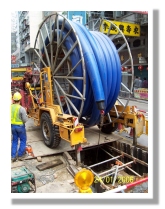
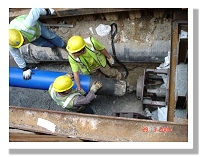
Through our continuous effort, the number of water main bursts has dropped to less than 40 in recent years. The disturbances due to disruption of traffic, loss of trade, inconvenience to the general public and disruption of water supply to consumers arising from main bursts are much minimised.
While the risk-based improvement of water mains maintains the healthiness of the water supply networks and reduces the risks of water main burst and leak in a preventive manner, implementation of the works inevitably affects the community. We will strive to minimise these implications. At the same time, the support of the community will continue to be the very important key to our success.
During construction, the contractors will submit detailed temporary traffic management schemes using updated traffic counts and on-site trial runs for the works where necessary. The temporary traffic management schemes have to be approved by the relevant authorities prior to implementation. It is expected that the traffic impacts arising from the works can be kept within acceptable level.
Besides, at locations where traffic impacts are more acute, we would consider using trenchless / minimum dig techniques to alleviate the traffic impacts.
During construction, the contractors will implement suitable environmental mitigation measures in compliance with the relevant statutory and contract requirements. It is expected that the environmental impacts arising from the works can be kept to the minimum.
Apart from the inconvenience to the public caused by the works, water supply to consumers may also be affected as the works will involve disconnections from the old pipelines and connections to the new pipelines.
In order to minimise the disruption of water supply to consumers, we endeavour to keep the number of water supply suspensions and the duration of each water supply suspension to a minimum by suitable planning of the works. In general, we will limit the duration of water supply suspension to within 8 hours. Affected consumers will be consulted and advance notification will be given.